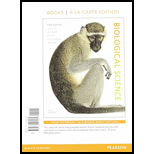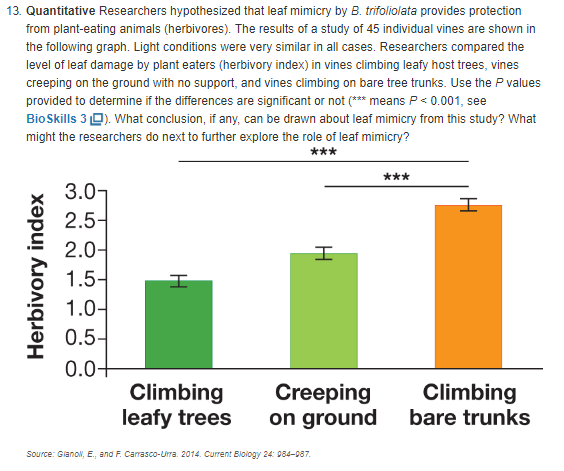
Concept explainers
Quantitative Researchers hypothesized that leaf mimicry by B. trifoliolata provides protection from plant-eating animals (herbivores). The results of a study of 45 individual vines are shown in the following graph. Light conditions were very similar in all cases. Researchers compared the level of leaf damage by plant eaters (herbivory index) in vines climbing leafy host trees, vines creeping on the ground with no support, and vines climbing on bare tree trunks. Use the P values provided to determine if the differences are significant or not (*** means P < 0.001, see BioSkills 3). What conclusion, if any, can be drawn about leaf mimicry from this study? What might the researchers do next to further explore the role of leaf mimicry?

Want to see the full answer?
Check out a sample textbook solution
Chapter 1 Solutions
Biological Science, Books a la Carte Plus Mastering Biology with Pearson eText -- Access Card Package (6th Edition)
- Make a simple model illustrating how tomato plants might be able to detect insects on a neighboring plant and protect themselves from infestation and how the components of this system interact. Show how fungi transfer information from insect-infested tomato plants to nearby uninfested tomato plants. Be sure to label any inputs and outputs in the model.arrow_forwardHow do the authors of the study interpret the information shown in Figure 3? (Choose one.) Group of answer choices The speed (number of days) at which fig saplings die from wilting disease is much faster when the saplings are inoculated with two species of fungi at the same time, compared to only one of the species. The number of days which saplings survive is significantly longer when fig saplings are inoculated with C. ficicola and F. kuroshium at the same time, compared to just inoculated with C. ficicola. There were significantly higher densities of C. ficicola than of F. kuroshium found in plants suffering from fig wilt disease. The number of saplings dying from fig wilt disease was significantly higher in plants inoculated with C. ficicola than in plants inoculated with F. kuroshium plus C. ficicola.arrow_forwardIf raising honeybees as pollinators becomes unprofitable because of colony collapse, what alternatives do farmers have?arrow_forward
- How might humans interact with the system of insect infestation in tomatos in order to produce plants with a strong defense against insect infestation (simply answer please)arrow_forwardIntraspecific competition is a competition between members of the same species and is commonly observed in crop plants. Table 6.2 shows the results of a greenhouse experiment which examined the effects of density on the germination and growth of barley. Plants were grown for two weeks in 10- cm diameter pots kept in identical environmental conditions and watered regularly. At the end of the experiment the plants were cropped by cutting the stems at the soil surface. Explain why knowledge of the effects in density is important to the crop farmer.arrow_forwardDescribe the behavior of ants when the trail was blocked. How did they establish or reestablish the trail? Explain the mechanism of trail establishment or reestablishment.arrow_forward
- interpret the following graph: In the graph, the number of days are 18.. 1 day is equal to 60 sec. days are taken on x-axis. The mean foraging times are taken on y-axis.arrow_forwardMatch the following situations with their correct interactions. Choose between mutualism, commensalism and parasitism. Leaf cutter ants cultivate a fungal garden to feed the fungus to the ant larvae. Answer Tongue-eating louse attach to a fish’s tongue and feed on the fish blood while acting like a normal tongue. Answer Barnacles on a whale are exposed to new food sources while living on the whale’s backs. Answer Japanese spider crabs have algae living on their shell for camouflage. Answer Mites attach to beetles for easy transportation from one location to another. Answerarrow_forwardWhich of the following describes a mutualistic relationship between insects and multicellular plants? Interactions between Rhizobium and the Fabaceae family Interactions between mycorrhizae and trees Interactions related to acacia trees Lichens Corals and Zooxanthellae Interactions between a host and a cleaner speciesarrow_forward
- Show a picture or draw Of Rice plant with the pest repellent property of Basil leaves (3d Model)arrow_forwardWhat could be the purpose of studying Mangroves parasitism?arrow_forward(i) DO NOT COPY HERE ON GOOGLE AND BARTLEBY Questions: In cacti, the leaves are reduced into spines. Give some reasons why the cacti underwent such modification.arrow_forward
 Biology: The Dynamic Science (MindTap Course List)BiologyISBN:9781305389892Author:Peter J. Russell, Paul E. Hertz, Beverly McMillanPublisher:Cengage Learning
Biology: The Dynamic Science (MindTap Course List)BiologyISBN:9781305389892Author:Peter J. Russell, Paul E. Hertz, Beverly McMillanPublisher:Cengage Learning
